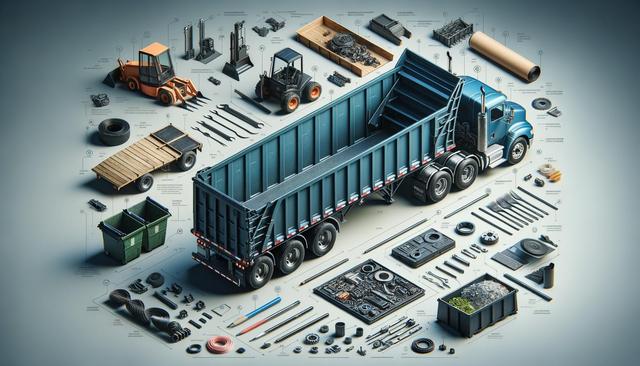Understanding Your Purpose and Load Requirements
Before you start comparing dumpster trailers, it’s essential to define what you’ll be using it for. Dumpster trailers come in various configurations, each designed with specific tasks in mind. Whether you’re handling construction debris, landscaping waste, or general cleanouts, identifying your primary use will guide you toward a model that meets your load type and capacity needs.
Consider the following when determining your requirements:
- Type of material you’ll be hauling (e.g., heavy concrete vs. lightweight yard waste)
- Frequency and volume of use
- Access to dump sites and road conditions
Load capacity is another core consideration. Trailer sizes often range from 7 to 20 cubic yards, with weight limits varying accordingly. Underestimating your frequent load weight can lead to safety risks and potential trailer damage, while overestimating could mean paying more than necessary for unused space.
Frame Construction and Material Durability
The durability of your dumpster trailer hinges on the quality of its frame and materials. Steel frames are highly regarded for their strength and resilience, particularly for heavy-duty use. However, not all steel is created equal. Look for trailers with reinforced joints, rust-resistant coatings, and a well-engineered chassis structure.
Key materials and construction features to check include:
- Galvanized or powder-coated steel for corrosion resistance
- Thick gauge metal walls and floors
- Welded seams versus bolted for structural integrity
Additionally, assess the quality of the trailer’s bed. A solid, one-piece construction typically lasts longer and resists warping. If you plan to offload large volumes frequently, a reinforced floor can prevent denting and extend the trailer’s lifespan.
Hydraulic Systems and Dumping Mechanism
One of the defining features of a dumpster trailer is its dumping mechanism, usually powered by a hydraulic system. A reliable hydraulic lift ensures smoother and safer unloading, especially when dealing with heavy contents. When evaluating hydraulic systems, focus on power, reliability, and ease of use.
Important considerations include:
- Hydraulic pump capacity and power source (battery-powered or electric)
- Lift angle for effective dumping
- Control mechanisms (remote or manual operation)
Some trailers offer a scissor-lift design, which provides greater lifting strength and stability compared to single or dual-ram systems. It’s also worth checking the response time of the lift and whether it supports partial dumps for more control during the process.
Axle Configuration and Suspension Type
The axle and suspension system significantly impact a trailer’s towing performance, especially when fully loaded. Dumpster trailers typically come with either single or tandem axle configurations. While single axles are sufficient for lighter loads and occasional use, tandem axles provide better stability and weight distribution for frequent or heavy-duty hauling.
Suspension types matter as well. Leaf spring suspensions are common and reliable, but torsion axles offer a smoother ride and lower maintenance. Depending on the terrain and distance you plan to travel, this could make a noticeable difference in long-term use and towing comfort.
Don’t overlook these axle-related details:
- Axle rating to match your hauling weight
- Brake system (electric brakes provide better control)
- Wheel size and tire quality
Ensuring your trailer’s axle setup aligns with your towing vehicle’s capabilities is critical for safety and compliance.
Additional Features and Customization Options
Beyond the core specifications, many dumpster trailers offer additional features that enhance usability and convenience. While not always essential, these extras can save time, improve efficiency, and contribute to a better overall experience.
Look for features such as:
- Built-in tarp systems to secure loads
- Swing or barn doors for easier access
- LED lighting for visibility and safety
- Storage compartments for tools and accessories
Customization options, such as removable sides or adjustable hitch heights, can also make a trailer more versatile. If you anticipate changing needs or multi-purpose use, investing in a model that allows for upgrades or changes over time may offer better long-term value.
Before finalizing your purchase, check the warranty and after-sales support offered by the manufacturer. A strong warranty can be a good indicator of product quality and peace of mind for the buyer.
Conclusion: Making an Informed Dumpster Trailer Purchase
Buying a dumpster trailer is a significant investment, especially for contractors, property managers, or small business owners who rely on dependable hauling solutions. By understanding your needs and evaluating the trailer’s construction, hydraulics, axle configuration, and extra features, you can make a more informed decision that aligns with your workload and budget. Focus on durability, functionality, and support to ensure your trailer serves you reliably for years to come.






